
NGC 300 (also known as Caldwell 70 or the Sculptor Pinwheel Galaxy) is a spiral galaxy in the constellation Sculptor. It is one of the closest galaxies to the Local Group, and probably lies between the latter and the Sculptor Group. It is the brightest of the five main spirals in the direction of the Sculptor Group. It is inclined at an angle of 42° when viewed from Earth and shares many characteristics of the Triangulum Galaxy. It is 94,000 light-years in diameter, somewhat smaller than the Milky Way, and has an estimated mass of (2.9 ± 0.2) × 1010M☉.
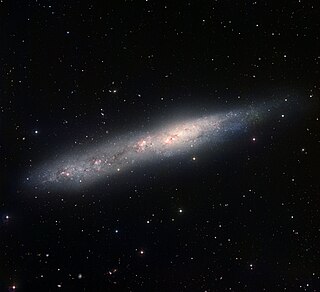
NGC 55, also known as the String of Pearls Galaxy, is a Magellanic type barred spiral galaxy located about 6.5 million light-years away in the constellation Sculptor. Along with its neighbor NGC 300, it is one of the closest galaxies to the Local Group, probably lying between the Milky Way and the Sculptor Group. It has an estimated mass of (2.0 ± 0.4) × 1010M☉.
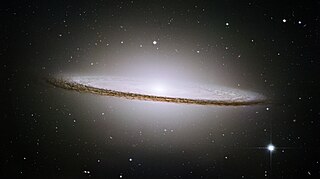
The Sombrero Galaxy is a peculiar galaxy of unclear classification in the constellation borders of Virgo and Corvus, being about 9.55 megaparsecs from the Milky Way galaxy. It is a member of the Virgo II Groups, a series of galaxies and galaxy clusters strung out from the southern edge of the Virgo Supercluster. It has an isophotal diameter of approximately 29.09 to 32.32 kiloparsecs, making it slightly bigger in size than the Milky Way.

Messier 9 or M9 is a globular cluster in the constellation of Ophiuchus. It is positioned in the southern part of the constellation to the southwest of Eta Ophiuchi, and lies atop a dark cloud of dust designated Barnard 64. The cluster was discovered by French astronomer Charles Messier on June 3, 1764, who described it as a "nebula without stars". In 1783, English astronomer William Herschel was able to use his reflector to resolve individual stars within the cluster. He estimated the cluster to be 7–8′ in diameter with stars densely packed near the center.

Messier 52 or M52, also known as NGC 7654 or the Scorpion Cluster, is an open cluster of stars in the highly northern constellation of Cassiopeia. It was discovered by Charles Messier in 1774. It can be seen from Earth under a good night sky with binoculars. The brightness of the cluster is influenced by extinction, which is stronger in the southern half. Its metallicity is somewhat below that of the Sun, and is estimated to be [Fe/H] = −0.05 ± 0.01.

The Owl Nebula is a planetary nebula approximately 2,030 light years away in the constellation Ursa Major. Estimated to be about 8,000 years old, it is approximately circular in cross-section with a faint internal structure. It was formed from the outflow of material from the stellar wind of the central star as it evolved along the asymptotic giant branch. The nebula is arranged in three concentric shells, with the outermost shell being about 20–30% larger than the inner shell. The owl-like appearance of the nebula is the result of an inner shell that is not circularly symmetric, but instead forms a barrel-like structure aligned at an angle of 45° to the line of sight.
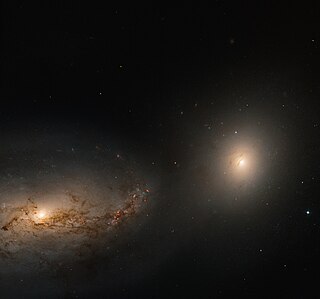
NGC 3227 is an intermediate spiral galaxy that is interacting with the dwarf elliptical galaxy NGC 3226. The two galaxies are one of several examples of a spiral with a dwarf elliptical companion that are listed in the Atlas of Peculiar Galaxies. Both galaxies may be found in the constellation Leo. It is a member of the NGC 3227 Group of galaxies, which is a member of the Leo II Groups, a series of galaxies and galaxy clusters strung out from the right edge of the Virgo Supercluster.

NGC 520, also known as the Flying Ghost, is a pair of colliding spiral galaxies about 105 million light-years away in the constellation Pisces. They were discovered by astronomer William Herschel on 13 December 1784.

NGC 2261 is a variable nebula located in the constellation Monoceros. The nebula is illuminated by the star R Monocerotis, which is not directly visible itself.

IC 2560 is a spiral galaxy lying over 110 million light-years away from Earth in the constellation of Antlia. It was discovered by Lewis Swift in 1897.
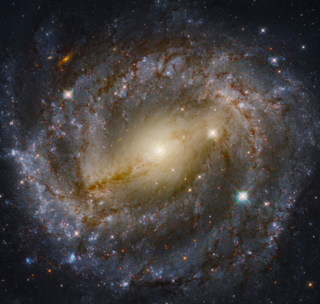
NGC 5643 is an intermediate spiral galaxy in the constellation Lupus. Based on the tip of the red-giant branch distance indicator, it is located at a distance of about 40 million light-years. NGC 5643 has an active galactic nucleus and is a type II Seyfert galaxy.

NGC 3941 is a barred lenticular galaxy located in the constellation Ursa Major. It is located at a distance of circa 40 million light years from Earth, which, given its apparent dimensions, means that NGC 3941 is about 40,000 light years across. It was discovered by William Herschel in 1787.
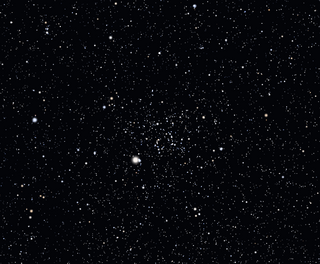
NGC 2539 is an open cluster in the constellation Puppis, located at the north edge of the constellation. It was discovered by William Herschel on January 31, 1785. It is a moderately rich cluster and with little central concentration, with Trumpler class II1m.

NGC 6028 is a barred lenticular galaxy and a ring galaxy located about 200 million light-years away in the constellation Hercules. Ring galaxies such as NGC 6028 are also known as Hoag-type galaxies as they may have a resemblance to the prototype, Hoag's Object. NGC 6028 was discovered by astronomer William Herschel on March 14, 1784. It was then rediscovered by astronomer Guillaume Bigourdan on May 4, 1886.
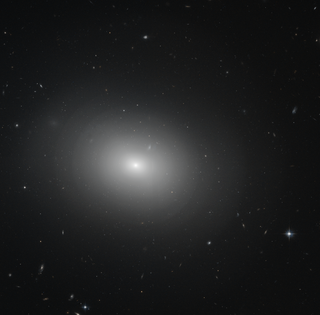
NGC 5982 is an elliptical galaxy located in the constellation Draco. It is located at a distance of circa 130 million light years from Earth, which, given its apparent dimensions, means that NGC 5982 is about 100,000 light years across. It was discovered by William Herschel on May 25, 1788.

NGC 3585 is an elliptical or a lenticular galaxy located in the constellation Hydra. It is located at a distance of circa 60 million light-years from Earth, which, given its apparent dimensions, means that NGC 3585 is about 80,000 light years across. It was discovered by William Herschel on December 9, 1784.

NGC 5846 is an elliptical galaxy located in the constellation Virgo. It is located at a distance of circa 90 million light years from Earth, which, given its apparent dimensions, means that NGC 5846 is about 110,000 light years across. It was discovered by William Herschel on February 24, 1786. It lies near 110 Virginis and is part of the Herschel 400 Catalogue. It is a member of the NGC 5846 Group of galaxies, itself one of the Virgo III Groups strung out to the east of the Virgo Supercluster of galaxies.

NGC 545 is a lenticular galaxy located in the constellation Cetus. It is located at a distance of about 250 million light years from Earth, which, given its apparent dimensions, means that NGC 545 is about 180,000 light years across. It was discovered by William Herschel on October 1, 1785. It is a member of the Abell 194 galaxy cluster and is included along with NGC 547 in the Atlas of Peculiar Galaxies.

NGC 6778 is a planetary nebula (PN) located about 10,300 light years away from the Sun in the equatorial constellation of Aquila. It is positioned 5° to the SSW of the prominent star Delta Aquilae. This nebula was discovered by German astronomer Albert Marth during the period 1863–1865. English astronomer John Herschel may have mistakenly catalogued it as NGC 6785, as nothing can be found now at the coordinates he gave for it. In the New General Catalogue it was described as a "small, elongated, ill-defined disc".
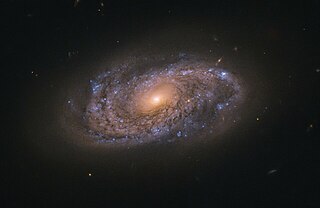
NGC 2906 is a spiral galaxy located in the constellation Leo. It is located at a distance of circa 120 million light years from Earth, which, given its apparent dimensions, means that NGC 2906 is about 75,000 light years across. It was discovered by William Herschel on December 28, 1785.





















